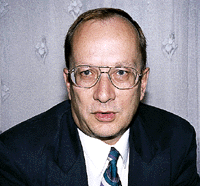
Dr. med. H. Schmidt
Medical Director
Children's Hospital Hoyerswerda
Chairman of the
Chamber of Physicians Hoyerswerda, Germany
M E D I C A L
R E S O N A N C E T H E R A P Y M U S I
C® a product of the Micro Music Laboratories®
leading medicine into the future
application of the natural harmony laws of the microcosm of music in favour
of health
© A A R E D I T I O N I N T E R N A T I O N A L 2001

Dr. med. H. Schmidt
Medical Director
Children's Hospital Hoyerswerda
Chairman of the
Chamber of Physicians Hoyerswerda, Germany
Dr. med.
Helmut Schmidt
Medical Director
Children's Hospital
With reference to your enquiry regarding our experiences with Medical Resonance
Therapy Music in the local children's hospital, I would like to comment as
follows:
Medical Resonance Therapy Music has been used in the children's hospital for approx. 1 1/2 years.
So far, we have seen the following indications:
a) With regard to patients
Prematurely and newly born babies in the intensive-care therapy unit for newly born babies.
We play the music to patients both in the incubator and in their cots.
We see that restless children clearly become calmer in their general behaviour, which also shows in a stabilisation of their breathing and heart frequency. With the tendency toward apnea in prematurely born babies, we have the impression that rhythmically distinct music has a more positive effect.
Intensive therapy patients with central-nervous disorders (encephalitis, drowning accidents, a condition following severe hypotension and reanimation of other genesis). For these children who are partly in a coma, and partly show an eretic condition, the patients are unable to comment themselves. The staff's impression is that the patients generally calm down, and also show a better tolerance of the necessary intensive-therapeutic measures.
Older children with psychosomatic disorders (e.g. Morbus Crohn, enuresis, anorexia, asthma bronchiale).
These children clearly articulate themselves after listening to the music. In most cases, the music is perceived as pleasant, and leads to a better tolerance of their stay in hospital. The danger is that Medical Resonance Therapy Music is used in single sequences that last too long, or is used too often during the day, which leads to the children being overtaxed, and subsequently rejecting the music.
Repeatedly damaged children with a severe statomotoric retardation.
These children frequently suffer from additional fits. During phases of a new adjustment of drugs for the fits, the children are restless an react to the music by clearly calming down.
b)
With regard to the interaction
of parents - child
Using Music Therapy in the treatment of children, produces a positive attitude in the parents towards the hospital, as this is perceived as part of the integrated care, and is gladly accepted. This becomes particularly apparent under the conditions of intensive therapy, where Medical Resonance Therapy Music as a complementary measure to the purely medical technology is perceived as very pleasant.
In the gentle care of premature babies, the "kangaroo method" plays a decisive role. During these times of intensive skin contact between mother and child, the music has an especially positive effect on the mother and child unit.
In extremely worried mothers, the constantly present pain of separation grows into a crisis situation when the child is admitted as an in-patient. Using Medical Resonance Therapy Music for these mothers, who sitting next to their child's bed, listen to this music, leads to a very distinct and swiftly visible dispersal of stress. We also keep seeing the same effect during the course of the in-hospital stay.
Prospects for the Future:
Spreading Peter Hübner's compositions more widely would be sensible, so that we could avoid encountering unknown music in the hospital.
I hope that these preliminary experiences are useful to the overall interest.

Dr. med. H. Schmidt